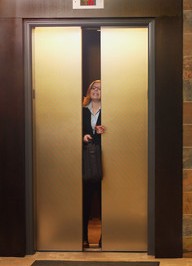
- Automobile Accidents
- Truck Accidents
- Medical Malpractice
- Maritime Accidents
- Product's Liability
- Premises Liability
- Dangerous Property Hazards
- Defective Sidewalks
- Electricity and Electrocution
- Elevator Accidents
- Slip and Fall Accidents
- Staircase Accidents
- Traffic Tickets
- Workers' Compensation
- Notary Public
- Immigration
- Business and Transactional Law
- General Consultations
- Criminal Law
- Traumatic Brain Injuries
Elevator Accidents
In 1853, Elisha Otis invented the “safety brake” which brought an elevator to a stop when the hoist rope broke. Mr. Otis’ company, Otis Elevator Company, installed the first passenger elevator in a New York building on March 23, 1857. It was powered by steam. Otis Elevator Co. is the world’s largest manufacturer and servicer of elevators.
Today’s elevators are usually hoisted by several cables with redundant safety features designed to prevent an elevator’s free fall if one cable breaks. Elevators in low rise buildings often use a hydraulic system in which fluid is pumped into a column underneath the elevator car to raise it and back into a reservoir to lower it.
According to a spokesman for the National Association of Elevator Safety Authorities International, “an elevator is a mechanical device, and anything that can go wrong will go wrong.” A federal report has found that from 1992-1998 at least 27 deaths occurred each year a result of elevator accidents. More than half of the deaths were suffered by the elevator inspectors or mechanics. Most deaths also involved someone falling down the shaft.
Modern elevators use electromagnetic brakes to stop the cars on demand. The braking systems grab onto the rail when the car brakes too quickly. If the elevator loses power, the electromagnets automatically clamp shut to prevent movement of the elevator. Door sensors are supposed to tell the elevator when the doors are open or closed. When doors are open, the elevators remain stopped. The doors are designed not to open unless the elevator’s arrival at a floor triggers the release of a safety “interlock.”
At the bottom of the elevator shaft, a heavy duty shock absorber is typically piston mounted in an oil filled cylinder. If the elevator falls, the system acts as a giant cushion to soften the car’s landing.
Notwithstanding the modern redundant safety systems of today’s elevators, revisions to the codes governing elevators are not retroactive, so older elevators do not have to be retrofitted to meet newer standards. Moreover, even the most modern elevators can be extremely unsafe if they have not been properly maintained.
The Elevator Escalator Safety Foundation recommends the following steps to ensure safety when on an elevator:
Look down before entering or leaving an elevator to avoid tripping if the car is not level with the floor
Keep clothing and packages away from the door to ensure that they are not caught when the elevator travels
If trapped in a broken elevator, never try to leave the car, Call for help
Never try to stop a closing elevator door by hand. Use the call button or wait for the next car
Never get into an overcrowded elevator





